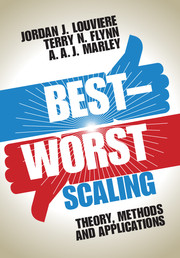Book contents
- Frontmatter
- Contents
- List of figures
- List of tables
- List of contributors to application chapters
- Preface
- Acknowledgments
- Theory and Methods
- 1 Introduction and overview of the book
- 2 The BWS object case
- 3 The BWS profile case
- 4 The BWS multi-profile case
- 5 Basic models
- 6 Looking forward
- Applications: Case 1
- Applications: Case 2
- Applications: Case 3
- References
- Subject index
- Author index
5 - Basic models
from Theory and Methods
Published online by Cambridge University Press: 05 October 2015
- Frontmatter
- Contents
- List of figures
- List of tables
- List of contributors to application chapters
- Preface
- Acknowledgments
- Theory and Methods
- 1 Introduction and overview of the book
- 2 The BWS object case
- 3 The BWS profile case
- 4 The BWS multi-profile case
- 5 Basic models
- 6 Looking forward
- Applications: Case 1
- Applications: Case 2
- Applications: Case 3
- References
- Subject index
- Author index
Summary
Everything should be made as simple as possible, but not simpler.
Attributed to Albert Einstein (1879–1955)5.1 Introduction
Louviere and Woodworth (1990) and Finn and Louviere (1992) developed the best-worst scaling method and developed and evaluated a probabilistic model of their Case 1 data. Recent research in this area has two rather distinct foci. The first is on the use of BWS as a method of collecting, say, ranking data, which is then modeled in various ways related to the multinomial logit for best choices or to weighted versions of the rank ordered logit for repeated best choices; the first four chapters of this book illustrate this approach.
The second focus is on developing mathematical models that might describe processes underlying the best and/or worst choices made by a person; this approach is well illustrated by Marley and Islam (2012), Marley and Louviere (2005), Marley and Pihlens (2012), Marley, Flynn and Louviere (2008) and Scarpa et al. (2011). This approach explores models in addition to the multinomial logit and weighted rank order logit for data collected by BWS. Many such models have different specifications and potentially different parameter values associated with the choice options and/or the attribute levels on latent scales.
Ideally, one should estimate using a statistical model suitable to a particular psychological process underlying the choices. This point is recognized in some (but by no means all) contexts, thanks to warnings in statistical software manuals. For example, the Stata manual cautions that, when one estimates an (exploded) rank ordered logistic regression model that assumes choices are ranked from top to bottom (best from n items, best from remaining n–1 items, …, best from the last two items), one will get slightly different results compared with a model that assumes that choices are ranked from bottom to top. Our experience suggests that differences in estimates are fairly small at an aggregate or subgroup level (for example, Louviere, Street et al., 2008; Flynn, Louviere, Peters et al., 2008), but individual-level models may require one to pay more attention to this issue. For example, a model might assume simultaneous, independent best and worst choices, but web-based or interviewer-administered surveys might use a structured sequential task that requires sequential choices. So, researchers should pay attention to task structures and, when possible, estimate model forms consistent with the way in which people make their choices.
- Type
- Chapter
- Information
- Best-Worst ScalingTheory, Methods and Applications, pp. 114 - 133Publisher: Cambridge University PressPrint publication year: 2015

